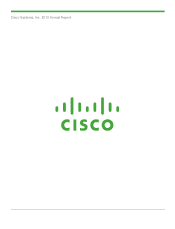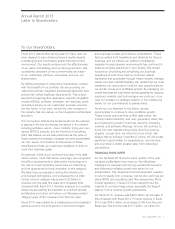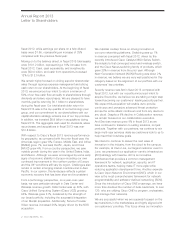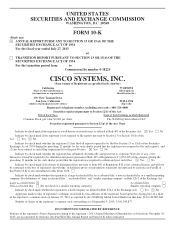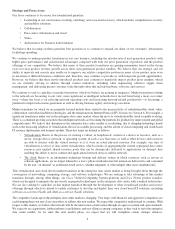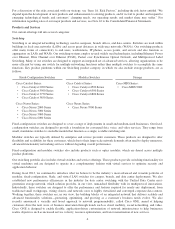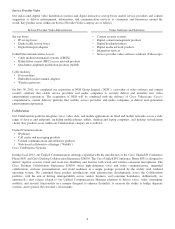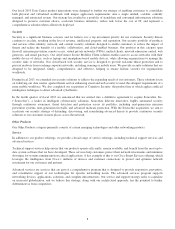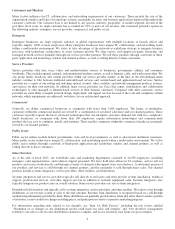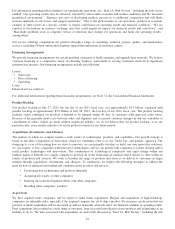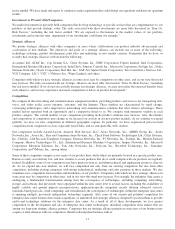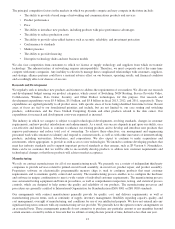Cisco 2013 Annual Report Download - page 11
Download and view the complete annual report
Please find page 11 of the 2013 Cisco annual report below. You can navigate through the pages in the report by either clicking on the pages listed below, or by using the keyword search tool below to find specific information within the annual report.compete more with certain strategic alliances and partners, and perhaps also encounter new competitors and partners in our attempt
to deliver the best solutions for our customers.
We are focusing on a market transition involving the move toward more programmable, flexible, and virtual networks,
sometimes called software defined networking, or SDN. This transition is focused on moving from a hardware-centric
approach for networking to a virtualized network environment that is designed to enable flexible, application-driven
customization of network infrastructures. We believe the successful products and solutions in this market will combine
application-specific integrated circuits (ASICs) with hardware and software elements together to meet customers’ total cost of
ownership, quality, security, scalability, and experience requirements. In our view, there is no single architecture that supports
all customer requirements in this area. Pursuant to our strategy which is targeted to address a broad range of specific customer
use cases, we will look to next steps that will follow the initial implementations that are under way.
We plan to address the SDN opportunity—to enable more open and programmable network infrastructure—with a broad
strategy and set of solutions. We introduced the Cisco Open Network Environment, or Cisco ONE, including overlay network
technology, application programming interfaces (APIs), and network-operation tools called agents and controllers, and we
have over 120 customers in a trial phase for these solutions.
We have also begun introducing our application-centric infrastructure (ACI) strategy, with the goal of going a step further to
transform network data centers to better address the demands of users who will be seeking access to new and current
applications on their networks. Specifically, ACI is a data center networking architecture designed to provide customer IT
networks with the ability to deliver business and other applications to end users with a simpler operational model, within a
secure and potentially expandable infrastructure, and in a cost-effective manner.
In our view, this evolution—driven by mobile device proliferation and cloud delivered data—is in early stages, but we believe
we have a differentiated strategy with a unique ability to deploy data centers in locations ranging from the campus to the
cloud. We intend to continue to drive internal innovation, partner for co-development, and make strategic investments to
deliver the highest value solutions to our customers.
We believe that the architectural approach that we have undertaken in the enterprise data center market is adaptable to other markets.
An example of a market where we aim to apply this approach is mobility, where growth of IP traffic on handheld devices is driving the
need for more robust architectures, equipment, and services in order to accommodate not only an increasing number of worldwide
mobile device users, but also increased user demand for broadband-quality business network and consumer web applications to be
delivered on such devices. A key term in this mobility-centered market transition is “BYOD,” an acronym for “bring your own
device,” which in the context of IT usage in companies, universities, and other organizations refers to the growing trend of employees,
customers, students, and others associated with such entities bringing and using their own laptop computers, smartphones, tablets, or
other mobile devices for their work or participation, instead of using equipment provided by the organization.
With regard to this market transition, to help such organizations meet the demands of increasing BYOD usage, our product
development strategy involves a comprehensive architectural approach that will allow for, among other things, a unified
security policy across the whole organization; a simplified operations and network management structure that understands
application performance from a user’s perspective, enhances troubleshooting capability, and lowers network operating costs;
and an uncompromised user experience over the organization’s entire wireless and wired network that embraces use of any
kind of device. Our mobility-related products and solutions reflect this architectural-based approach.
Other market transitions on which we are focusing particular attention include those related to the convergence of video,
collaboration, and networked mobility technologies, which we believe will drive productivity and growth in network loads and
which convergence appears to be evolving even more quickly and more significantly than we had previously anticipated.
Cisco TelePresence systems are one example of product offerings that have incorporated video, collaboration, and networked
mobility technologies as customers evolve their communications and business models. More generally, we are focused on
simplifying and expanding the creation, distribution, and use of end-to-end video solutions for businesses and consumers.
We believe that several current market transitions are combining into a potentially significant transition in the IP network
industry, which we refer to as the Internet of Everything (IoE). IoE refers to the networked connection of people, process, data,
and things, such as appliances, devices, and everyday objects, and is a market transition that we believe will create, by bringing
“everything” online, significant opportunities for organizations, communities, and countries to obtain greater value from
networked connections. In parallel with the anticipated proliferation in number of network-connected things, significant advances
have been made in Internet and network-related technologies such as the evolution of the cloud, the advent of IPv6, the
proliferation of mobile networking, and the increase in global broadband availability. These advances, in turn, are leading to
continuing increases in network capabilities which, in combination with the growth in number of IP connections, are reasons why
IoE has the potential to be a significant market transition that, we believe, may offer significant economic and societal benefits.
3

